Solutions for developing aquaculture and aquatic products consumption in coastal areas of Thanh hoa province
Thanh Hoa province which has a coastline of more than 100 km brings many
advantages to the development of aquaculture. In recent years, aquaculture has developed
rapidly, quite comprehensively, positively contributing to the growth of the agriculture and
socio-economic development of coastal districts. However, in the process of producing and
consuming aquatic products in these areas, there are still many difficulties and shortcomings.
In this study, the authors focus on SWOT analysis to show the potentials and challenges of
aquaculture and consumption of some key aquatic products (Meretrix lyrata and Litopenaeus
Vannamei). From which, the authors propose solutions to develop aquaculture and the
consumption of those key aquatic products in the coastal area of Thanh Hoa province.
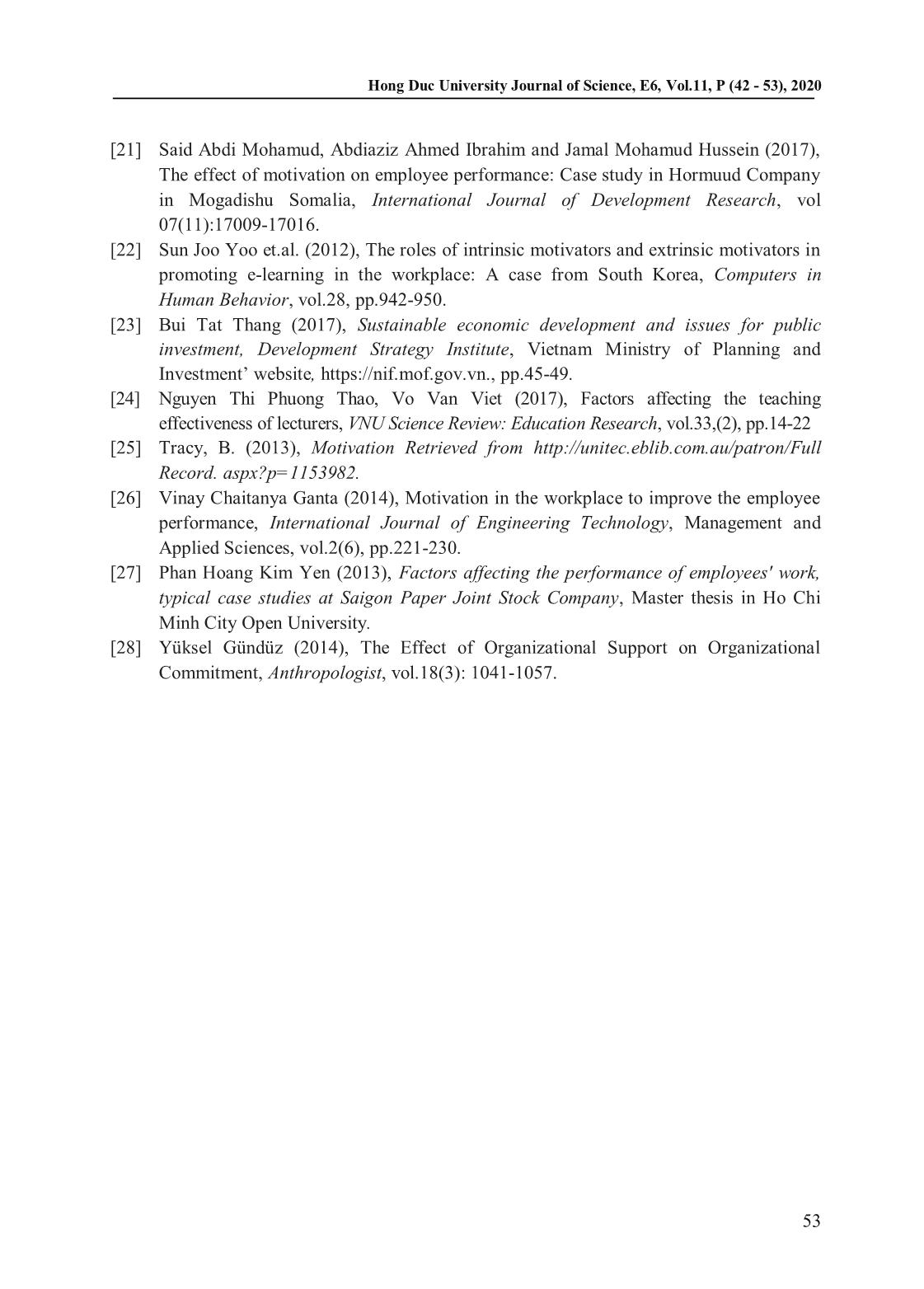
Trang 1

Trang 2

Trang 3
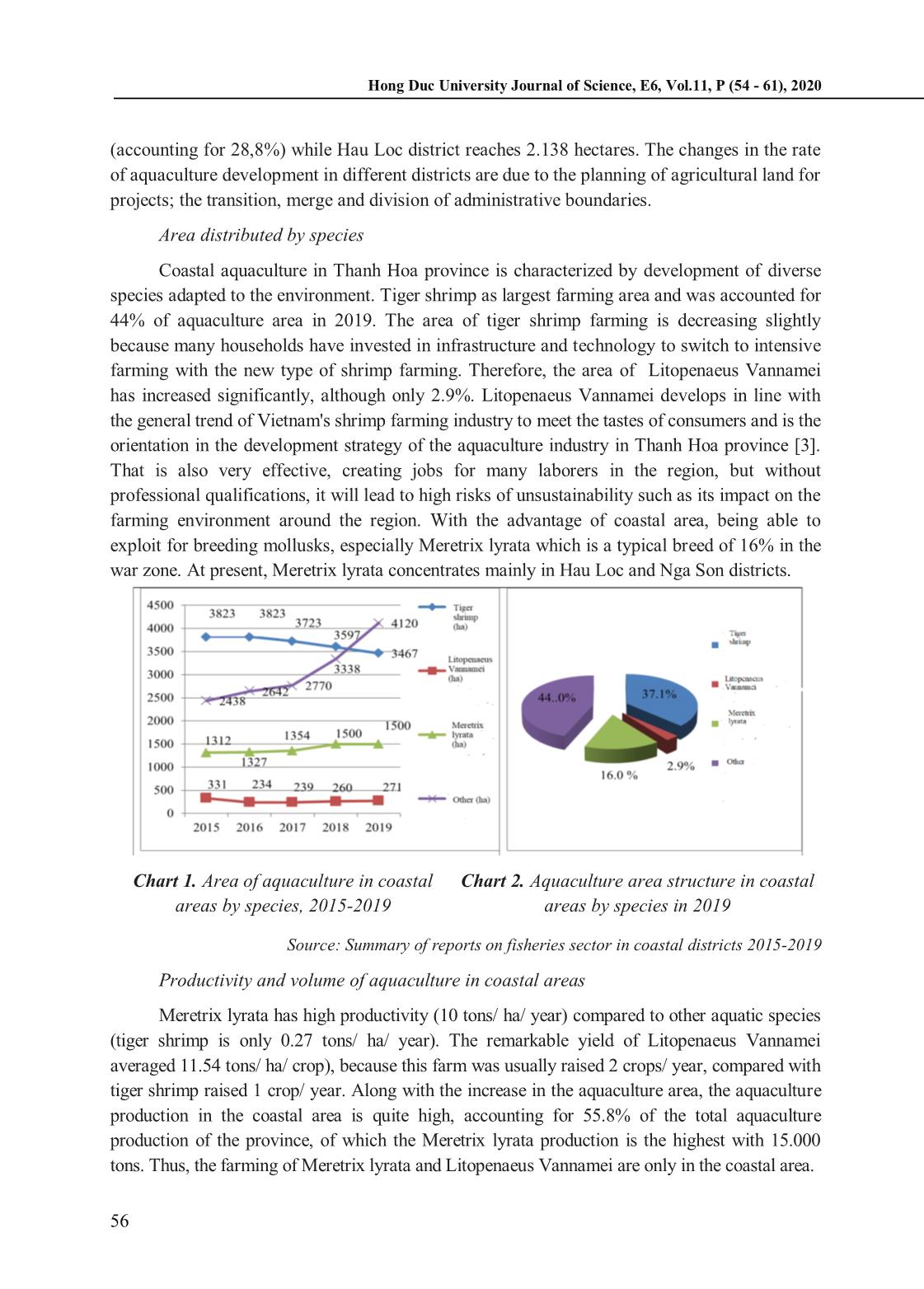
Trang 4
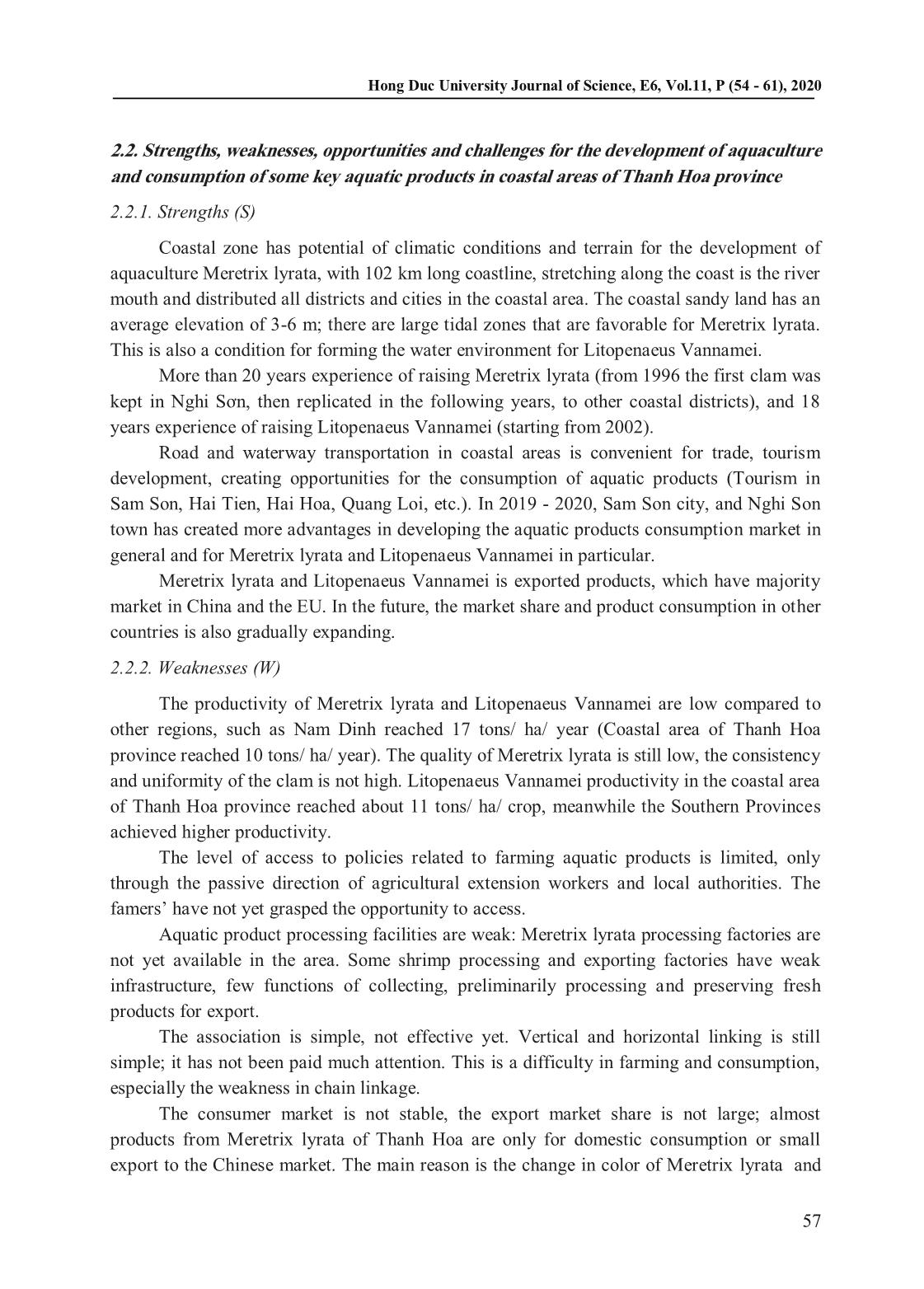
Trang 5
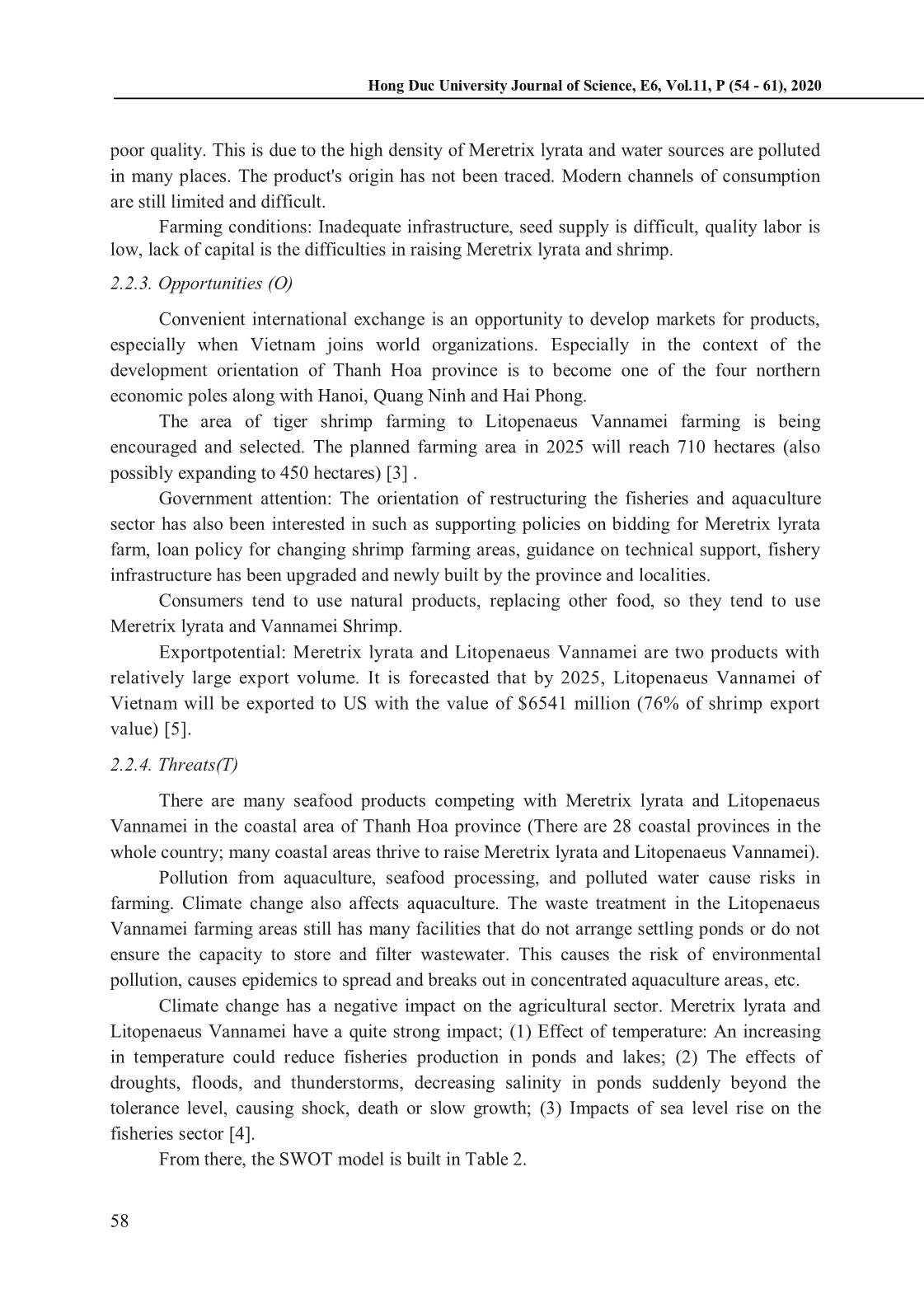
Trang 6
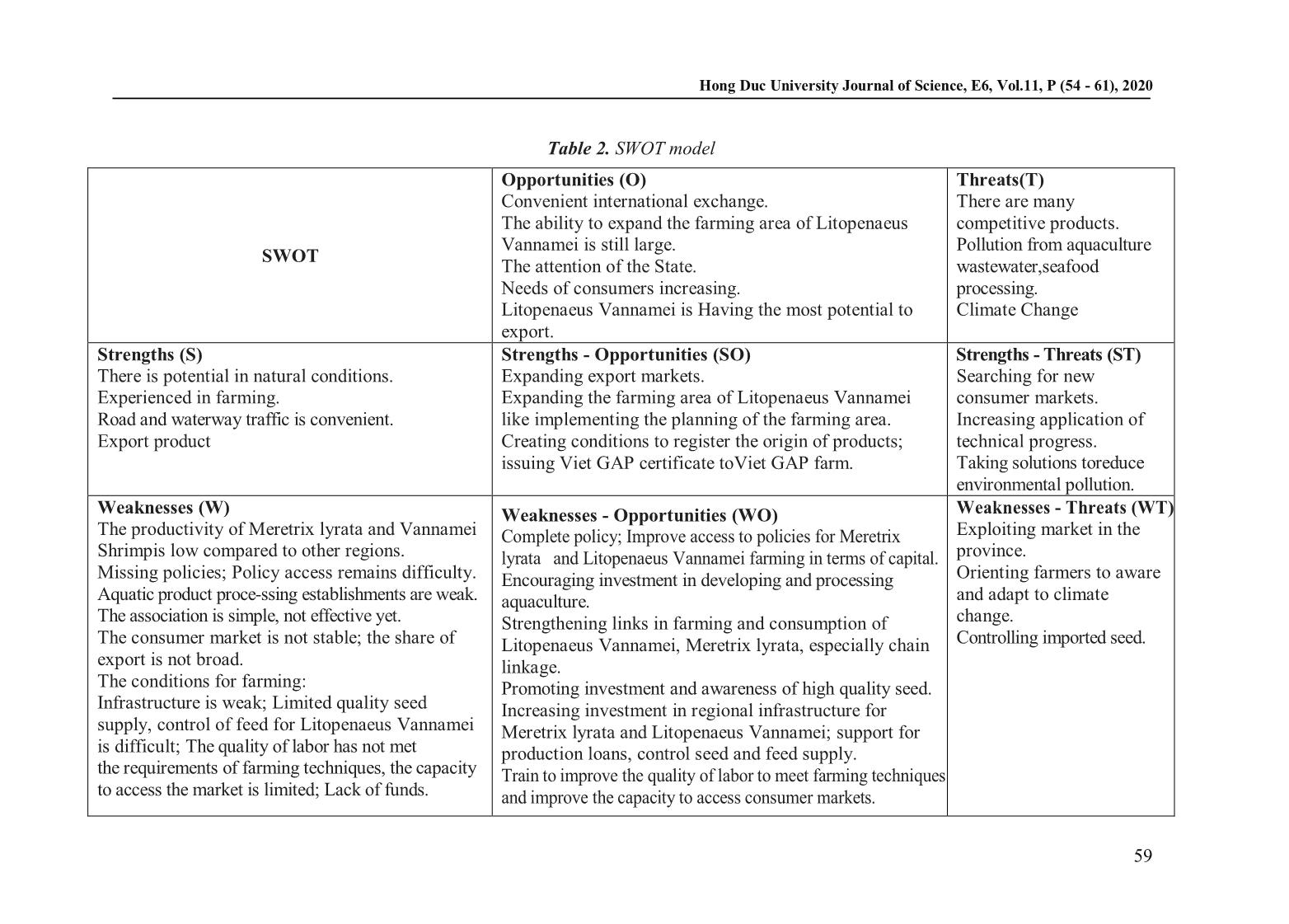
Trang 7
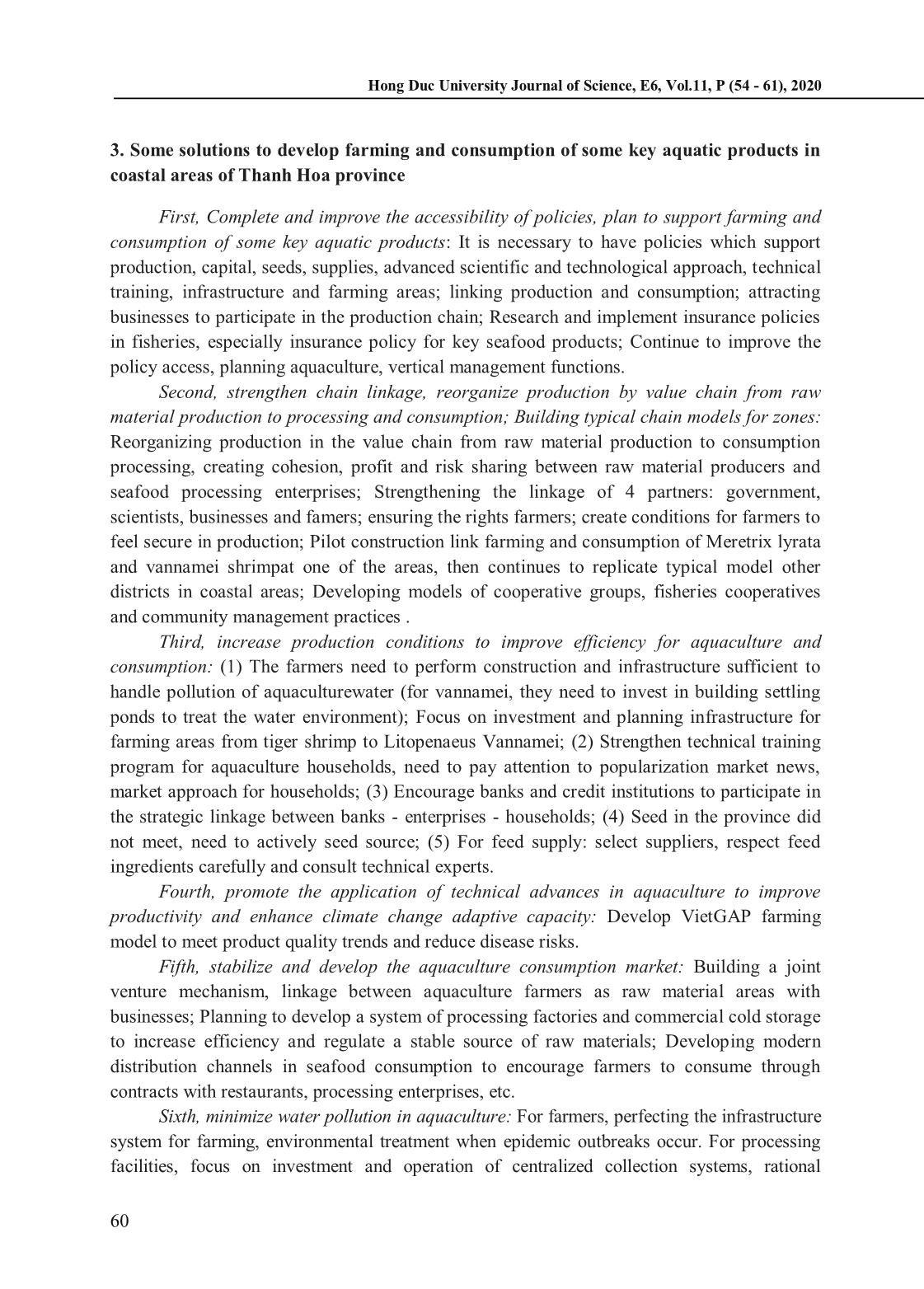
Trang 8
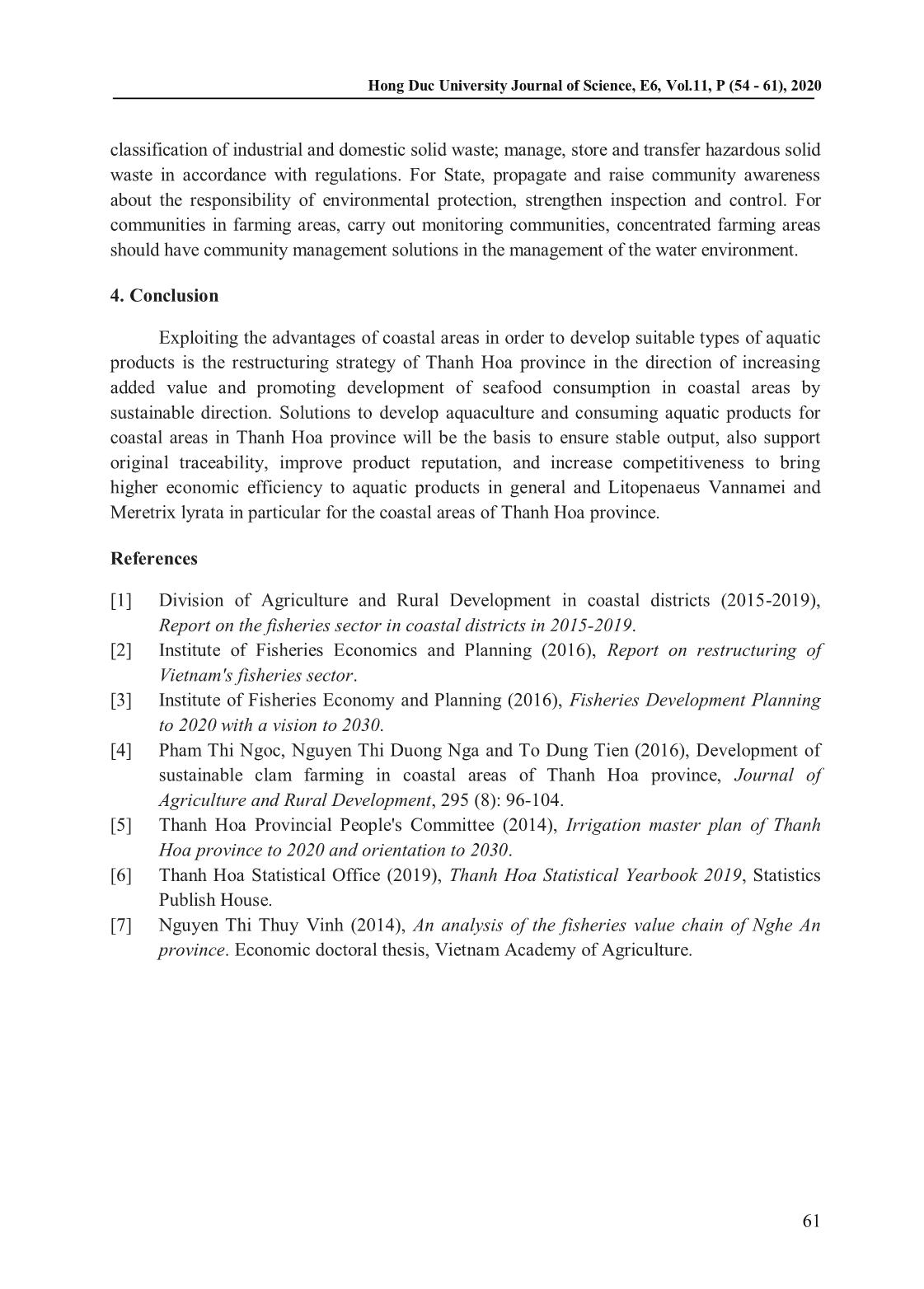
Trang 9
Tóm tắt nội dung tài liệu: Solutions for developing aquaculture and aquatic products consumption in coastal areas of Thanh hoa province
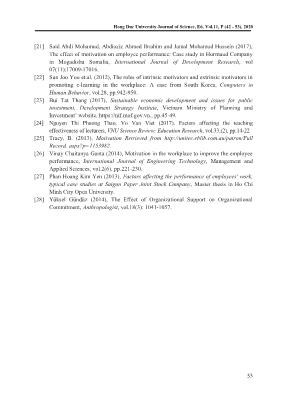
Hong Duc University Journal of Science, E6, Vol.11, P (42 - 53), 2020 53 F ac. o f G rad . S tu d ies, M ah id o l U n iv . M . M . (In tern atio n al H o sp itality M an ag em en t) / 5 3 [21] Said Abdi Mohamud, Abdiaziz Ahmed Ibrahim and Jamal Mohamud Hussein (2017), The effect of motivation on employee performance: Case study in Hormuud Company in Mogadishu Somalia, International Journal of Development Research, vol 07(11):17009-17016. [22] Sun Joo Yoo et.al. (2012), The roles of intrinsic motivators and extrinsic motivators in promoting e-learning in the workplace: A case from South Korea, Computers in Human Behavior, vol.28, pp.942-950. [23] Bui Tat Thang (2017), Sustainable economic development and issues for public investment, Development Strategy Institute, Vietnam Ministry of Planning and Investment‟ website, https://nif.mof.gov.vn., pp.45-49. [24] Nguyen Thi Phuong Thao, Vo Van Viet (2017), Factors affecting the teaching effectiveness of lecturers, VNU Science Review: Education Research, vol.33,(2), pp.14-22 [25] Tracy, B. (2013), Motivation Retrieved from Record. aspx?p=1153982. [26] Vinay Chaitanya Ganta (2014), Motivation in the workplace to improve the employee performance, International Journal of Engineering Technology, Management and Applied Sciences, vol.2(6), pp.221-230. [27] Phan Hoang Kim Yen (2013), Factors affecting the performance of employees' work, typical case studies at Saigon Paper Joint Stock Company, Master thesis in Ho Chi Minh City Open University. [28] Yüksel Gündüz (2014), The Effect of Organizational Support on Organizational Commitment, Anthropologist, vol.18(3): 1041-1057. Hong Duc University Journal of Science, E6, Vol.11, P (54 - 61), 2020 54 F ac. o f G rad . S tu d ies, M ah id o l U n iv . M . M . (In tern atio n al H o sp itality M an ag em en t) / 5 4 SOLUTIONS FOR DEVELOPING AQUACULTURE AND AQUATIC PRODUCTS CONSUMPTION IN COASTAL AREAS OF THANH HOA PROVINCE Le Thi Minh Hue, Pham Thi Ngoc 1 Received: 10 August 2020/ Accepted: 1 September 2020/ Published: September 2020 Abstract: Thanh Hoa province which has a coastline of more than 100 km brings many advantages to the development of aquaculture. In recent years, aquaculture has developed rapidly, quite comprehensively, positively contributing to the growth of the agriculture and socio-economic development of coastal districts. However, in the process of producing and consuming aquatic products in these areas, there are still many difficulties and shortcomings. In this study, the authors focus on SWOT analysis to show the potentials and challenges of aquaculture and consumption of some key aquatic products (Meretrix lyrata and Litopenaeus Vannamei). From which, the authors propose solutions to develop aquaculture and the consumption of those key aquatic products in the coastal area of Thanh Hoa province. Keywords: Aquatic products, aquaculture, consuming, Meretrix lyrata, Litopenaeus Vannamei, coastal area, Thanh Hoa province. 1. Introduction Fishery is an important industry in the economy of Vietnam. The Prime Minister's Decision No. 332/QD-TTg dated March 3 rd , 2011, mentioned rapid development of aquaculture in industrialization, modernization, efficiency, high competitiveness and sustainable development orientation; to become the main production industry that provides raw materials for export and domestic consumption; at the same time creating more jobs, increasing income for farmers and fishermen, ensuring social security, contributing to poverty reduction and protecting national security. The Decision No. 1445/QD-TTg dated August 16 th , 2013 of the Prime Minister clearly stated that the fisheries sector will basically be industrialized by 2020, modernized by 2030 and continue developing comprehensively and effectively and becoming a large production industry, with reasonable production structure and forms, with high productivity, quality, efficiency and competitiveness. The estimated total fishery production would be about 7.0 million tons; Seafood export value would be about 11 billion USD. The coastal area of Thanh Hoa province, with 6 districts, towns and cities, has potentials for developing aquaculture. Thanh Hoa province plans to orient and focus on raising Meretrix lyrata and Litopenaeus Vannamei (Meretrix lyrata takes advantage of the existing coastal areas, and Litopenaeus Vannamei is a product with the orientation to expand Le Thi Minh Hue, Pham Thi Ngoc Faculty of Economic and Bussiness Administration, Hong Duc University Email: lethiminhhue@hdu.edu.vn ( ) Hong Duc University Journal of Science, E6, Vol.11, P (54 - 61), 2020 55 F ac. o f G rad . S tu d ies, M ah id o l U n iv . M . M . (In tern atio n al H o sp itality M an ag em en t) / 5 5 and meet the needs of consumers with higher efficiency). However, in the process of producing and consuming aquatic products in coastal areas, there are still many difficulties and shortcomings such as: Policy access is not timely and sufficient; consumption market is not stable, production resources such as food, seeds, labor are still weak, the environment is still polluted, etc. Therefore, there should be key solutions to develop aquaculture and consume aquatic products in coastal areas of Thanh Hoa province towards the strategic goals. In this study, we focus on SWOT analysis to see the potentials and challenges in aquaculture and consumption of aquaculture (Meretrix lyrata and Litopenaeus Vannamei). From which, we propose solutions to develop farming and consumption of some key aquatic products in the coastal area of Thanh Hoa province. 2. Research results and discussion 2.1. Current status of cultivating some aquatic products in Thanh Hoa coastal areas The aquaculture area is divided ... tages in developing the aquatic products consumption market in general and for Meretrix lyrata and Litopenaeus Vannamei in particular. Meretrix lyrata and Litopenaeus Vannamei is exported products, which have majority market in China and the EU. In the future, the market share and product consumption in other countries is also gradually expanding. 2.2.2. Weaknesses (W) The productivity of Meretrix lyrata and Litopenaeus Vannamei are low compared to other regions, such as Nam Dinh reached 17 tons/ ha/ year (Coastal area of Thanh Hoa province reached 10 tons/ ha/ year). The quality of Meretrix lyrata is still low, the consistency and uniformity of the clam is not high. Litopenaeus Vannamei productivity in the coastal area of Thanh Hoa province reached about 11 tons/ ha/ crop, meanwhile the Southern Provinces achieved higher productivity. The level of access to policies related to farming aquatic products is limited, only through the passive direction of agricultural extension workers and local authorities. The famers‟ have not yet grasped the opportunity to access. Aquatic product processing facilities are weak: Meretrix lyrata processing factories are not yet available in the area. Some shrimp processing and exporting factories have weak infrastructure, few functions of collecting, preliminarily processing and preserving fresh products for export. The association is simple, not effective yet. Vertical and horizontal linking is still simple; it has not been paid much attention. This is a difficulty in farming and consumption, especially the weakness in chain linkage. The consumer market is not stable, the export market share is not large; almost products from Meretrix lyrata of Thanh Hoa are only for domestic consumption or small export to the Chinese market. The main reason is the change in color of Meretrix lyrata and Hong Duc University Journal of Science, E6, Vol.11, P (54 - 61), 2020 58 F ac. o f G rad . S tu d ies, M ah id o l U n iv . M . M . (In tern atio n al H o sp itality M an ag em en t) / 5 8 poor quality. This is due to the high density of Meretrix lyrata and water sources are polluted in many places. The product's origin has not been traced. Modern channels of consumption are still limited and difficult. Farming conditions: Inadequate infrastructure, seed supply is difficult, quality labor is low, lack of capital is the difficulties in raising Meretrix lyrata and shrimp. 2.2.3. Opportunities (O) Convenient international exchange is an opportunity to develop markets for products, especially when Vietnam joins world organizations. Especially in the context of the development orientation of Thanh Hoa province is to become one of the four northern economic poles along with Hanoi, Quang Ninh and Hai Phong. The area of tiger shrimp farming to Litopenaeus Vannamei farming is being encouraged and selected. The planned farming area in 2025 will reach 710 hectares (also possibly expanding to 450 hectares) [3] . Government attention: The orientation of restructuring the fisheries and aquaculture sector has also been interested in such as supporting policies on bidding for Meretrix lyrata farm, loan policy for changing shrimp farming areas, guidance on technical support, fishery infrastructure has been upgraded and newly built by the province and localities. Consumers tend to use natural products, replacing other food, so they tend to use Meretrix lyrata and Vannamei Shrimp. Exportpotential: Meretrix lyrata and Litopenaeus Vannamei are two products with relatively large export volume. It is forecasted that by 2025, Litopenaeus Vannamei of Vietnam will be exported to US with the value of $6541 million (76% of shrimp export value) [5]. 2.2.4. Threats(T) There are many seafood products competing with Meretrix lyrata and Litopenaeus Vannamei in the coastal area of Thanh Hoa province (There are 28 coastal provinces in the whole country; many coastal areas thrive to raise Meretrix lyrata and Litopenaeus Vannamei). Pollution from aquaculture, seafood processing, and polluted water cause risks in farming. Climate change also affects aquaculture. The waste treatment in the Litopenaeus Vannamei farming areas still has many facilities that do not arrange settling ponds or do not ensure the capacity to store and filter wastewater. This causes the risk of environmental pollution, causes epidemics to spread and breaks out in concentrated aquaculture areas, etc. Climate change has a negative impact on the agricultural sector. Meretrix lyrata and Litopenaeus Vannamei have a quite strong impact; (1) Effect of temperature: An increasing in temperature could reduce fisheries production in ponds and lakes; (2) The effects of droughts, floods, and thunderstorms, decreasing salinity in ponds suddenly beyond the tolerance level, causing shock, death or slow growth; (3) Impacts of sea level rise on the fisheries sector [4]. From there, the SWOT model is built in Table 2. Hong Duc University Journal of Science, E6, Vol.11, P (54 - 61), 2020 59 F ac. o f G rad . S tu d ies, M ah id o l U n iv . M . M . (In tern atio n al H o sp itality M an ag em en t) / 5 9 Table 2. SWOT model SWOT Opportunities (O) Convenient international exchange. The ability to expand the farming area of Litopenaeus Vannamei is still large. The attention of the State. Needs of consumers increasing. Litopenaeus Vannamei is Having the most potential to export. Threats(T) There are many competitive products. Pollution from aquaculture wastewater,seafood processing. Climate Change Strengths (S) There is potential in natural conditions. Experienced in farming. Road and waterway traffic is convenient. Export product Strengths - Opportunities (SO) Expanding export markets. Expanding the farming area of Litopenaeus Vannamei like implementing the planning of the farming area. Creating conditions to register the origin of products; issuing Viet GAP certificate toViet GAP farm. Strengths - Threats (ST) Searching for new consumer markets. Increasing application of technical progress. Taking solutions toreduce environmental pollution. Weaknesses (W) The productivity of Meretrix lyrata and Vannamei Shrimpis low compared to other regions. Missing policies; Policy access remains difficulty. Aquatic product proce-ssing establishments are weak. The association is simple, not effective yet. The consumer market is not stable; the share of export is not broad. The conditions for farming: Infrastructure is weak; Limited quality seed supply, control of feed for Litopenaeus Vannamei is difficult; The quality of labor has not met the requirements of farming techniques, the capacity to access the market is limited; Lack of funds. Weaknesses - Opportunities (WO) Complete policy; Improve access to policies for Meretrix lyrata and Litopenaeus Vannamei farming in terms of capital. Encouraging investment in developing and processing aquaculture. Strengthening links in farming and consumption of Litopenaeus Vannamei, Meretrix lyrata, especially chain linkage. Promoting investment and awareness of high quality seed. Increasing investment in regional infrastructure for Meretrix lyrata and Litopenaeus Vannamei; support for production loans, control seed and feed supply. Train to improve the quality of labor to meet farming techniques, and improve the capacity to access consumer markets. Weaknesses - Threats (WT) Exploiting market in the province. Orienting farmers to aware and adapt to climate change. Controlling imported seed. Hong Duc University Journal of Science, E6, Vol.11, P (54 - 61), 2020 60 F ac. o f G rad . S tu d ies, M ah id o l U n iv . M . M . (In tern atio n al H o sp itality M an ag em en t) / 6 0 3. Some solutions to develop farming and consumption of some key aquatic products in coastal areas of Thanh Hoa province First, Complete and improve the accessibility of policies, plan to support farming and consumption of some key aquatic products: It is necessary to have policies which support production, capital, seeds, supplies, advanced scientific and technological approach, technical training, infrastructure and farming areas; linking production and consumption; attracting businesses to participate in the production chain; Research and implement insurance policies in fisheries, especially insurance policy for key seafood products; Continue to improve the policy access, planning aquaculture, vertical management functions. Second, strengthen chain linkage, reorganize production by value chain from raw material production to processing and consumption; Building typical chain models for zones: Reorganizing production in the value chain from raw material production to consumption processing, creating cohesion, profit and risk sharing between raw material producers and seafood processing enterprises; Strengthening the linkage of 4 partners: government, scientists, businesses and famers; ensuring the rights farmers; create conditions for farmers to feel secure in production; Pilot construction link farming and consumption of Meretrix lyrata and vannamei shrimpat one of the areas, then continues to replicate typical model other districts in coastal areas; Developing models of cooperative groups, fisheries cooperatives and community management practices . Third, increase production conditions to improve efficiency for aquaculture and consumption: (1) The farmers need to perform construction and infrastructure sufficient to handle pollution of aquaculturewater (for vannamei, they need to invest in building settling ponds to treat the water environment); Focus on investment and planning infrastructure for farming areas from tiger shrimp to Litopenaeus Vannamei; (2) Strengthen technical training program for aquaculture households, need to pay attention to popularization market news, market approach for households; (3) Encourage banks and credit institutions to participate in the strategic linkage between banks - enterprises - households; (4) Seed in the province did not meet, need to actively seed source; (5) For feed supply: select suppliers, respect feed ingredients carefully and consult technical experts. Fourth, promote the application of technical advances in aquaculture to improve productivity and enhance climate change adaptive capacity: Develop VietGAP farming model to meet product quality trends and reduce disease risks. Fifth, stabilize and develop the aquaculture consumption market: Building a joint venture mechanism, linkage between aquaculture farmers as raw material areas with businesses; Planning to develop a system of processing factories and commercial cold storage to increase efficiency and regulate a stable source of raw materials; Developing modern distribution channels in seafood consumption to encourage farmers to consume through contracts with restaurants, processing enterprises, etc. Sixth, minimize water pollution in aquaculture: For farmers, perfecting the infrastructure system for farming, environmental treatment when epidemic outbreaks occur. For processing facilities, focus on investment and operation of centralized collection systems, rational Hong Duc University Journal of Science, E6, Vol.11, P (54 - 61), 2020 61 F ac. o f G rad . S tu d ies, M ah id o l U n iv . M . M . (In tern atio n al H o sp itality M an ag em en t) / 6 1 classification of industrial and domestic solid waste; manage, store and transfer hazardous solid waste in accordance with regulations. For State, propagate and raise community awareness about the responsibility of environmental protection, strengthen inspection and control. For communities in farming areas, carry out monitoring communities, concentrated farming areas should have community management solutions in the management of the water environment. 4. Conclusion Exploiting the advantages of coastal areas in order to develop suitable types of aquatic products is the restructuring strategy of Thanh Hoa province in the direction of increasing added value and promoting development of seafood consumption in coastal areas by sustainable direction. Solutions to develop aquaculture and consuming aquatic products for coastal areas in Thanh Hoa province will be the basis to ensure stable output, also support original traceability, improve product reputation, and increase competitiveness to bring higher economic efficiency to aquatic products in general and Litopenaeus Vannamei and Meretrix lyrata in particular for the coastal areas of Thanh Hoa province. References [1] Division of Agriculture and Rural Development in coastal districts (2015-2019), Report on the fisheries sector in coastal districts in 2015-2019. [2] Institute of Fisheries Economics and Planning (2016), Report on restructuring of Vietnam's fisheries sector. [3] Institute of Fisheries Economy and Planning (2016), Fisheries Development Planning to 2020 with a vision to 2030. [4] Pham Thi Ngoc, Nguyen Thi Duong Nga and To Dung Tien (2016), Development of sustainable clam farming in coastal areas of Thanh Hoa province, Journal of Agriculture and Rural Development, 295 (8): 96-104. [5] Thanh Hoa Provincial People's Committee (2014), Irrigation master plan of Thanh Hoa province to 2020 and orientation to 2030. [6] Thanh Hoa Statistical Office (2019), Thanh Hoa Statistical Yearbook 2019, Statistics Publish House. [7] Nguyen Thi Thuy Vinh (2014), An analysis of the fisheries value chain of Nghe An province. Economic doctoral thesis, Vietnam Academy of Agriculture.
File đính kèm:
 solutions_for_developing_aquaculture_and_aquatic_products_co.pdf
solutions_for_developing_aquaculture_and_aquatic_products_co.pdf

